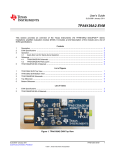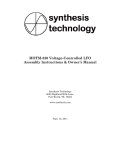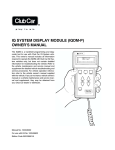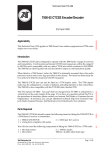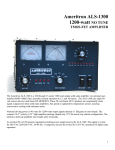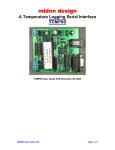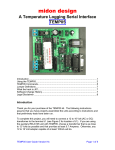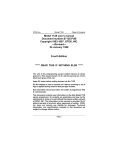Download VR100 Manual
Transcript
15182 Triton Lane #102 Huntington Beach CA 92649 VR-100 Vehicular Repeater Revision D Aug 25 1994 VR-100 Table of Contents Specifications ..................................................................................... 1 Introduction ........................................................................................ 2 Functional Description ....................................................................... 3 Trunking Operation ........................................................................... 4 Installation .......................................................................................... 5 Jumper Selection ................................................................................ 5 Radio Connections ............................................................................. 6 Alignment ........................................................................................... 8 RF Alignment ..................................................................................... 8 Repeater Alignment ........................................................................... 9 CTCSS Table .................................................................................... 10 Figure 1 RF Test Points ................................................................... 11 Crystals ............................................................................................. 11 Figure 2 VR-100 Parts Locator ........................................................ 12 Parts List ........................................................................................... 13 Schematic ......................................................................... Fold Out VR-100 Specifications General: Operation: Modes: Indicators: Interface: Adjustments: Jumpers: CTCSS: Motorola PAC/RT® compatible plus trunking. Priority, non-priority disabled, test mode. 8 high brightness LEDs, handheld queueing tones. 9 pin "D" connector with 6 ft. cable. Receive sensitivity, transmit dev., squelch threshold, local mic sens., lock tone decode frequency, lock tone dev., local speaker audio. COR polarity, on-air polarity, enable/disable polarity, Tx audio flat/de-emph., Rx audio flat/pre-emph. DIP switch selectable, 37 EIA tones + 69.3 & 97.4 Power Requirements: DC supply: Standby: Receive: Transmit: 13.6 VDC ±25% negative ground. 80 mA. 250 mA. 1.5 A. Physical: Dimensions: Weight: Case: 5.275"W x 6"L x 1.12"H. 18 oz. One piece extruded aluminium. Transmitter: Frequency Range: RF Power: Tx Spurious: Stability: FM Noise: Audio dist: Tx sens: Lock Tone: FCC TA: 450-470 MHz 0.25-2W adjustable -50dbc 5ppm -55db <5% 50mV-2.5V RMS Jumper selectable: 832.5 or 847.5Hz LRUVR-100U Parts 22, 90 Receiver: Frequency Range: Sensitivity: Mod Acceptance: Selectivity: Spurious/image rej.: IMD response: Stability: Lock Tone detect: Local Rx Audio: 450-470 MHz .4μV for 12db Sinad ±7.5kHz 70db 60db 65db 5ppm Tunable: 820 Hz to 930 Hz, 1% bandwidth 400mW into 8 Ohms Specifications Subject to Change without notification Page 1 VR-100 Introduction The Pyramid Communications model VR-100 is a microprocessor controlled low power vehicular repeater. It is designed to interface between a high power mobile radio and a low power UHF handheld. If the radio operator is out of the vehicle and the mobile radio is receiving a transmission, the VR-100 will repeat the signal to the users handheld. The user may also transmit back to the VR-100 via the handheld, and their transmission will be repeated back to the base by the high power mobile radio, effectively extending the range of the low power handheld. On-board logic control by the microprocessor ensures that only one vehicle will become active as the repeater, should several vehicles arrive at the same scene. The logic also handles cases where the priority vehicle leaves the scene (or fails), or another priority vehicle arrives from a different site. The model VR-100 is fully compatible with Motorola PAC/RT® systems, as well as GE Ericsson and Standard EX-10/ CTS-20 radios. Additionally, the VR-100 supports connection to LTR® or Motorola trunking radios, local mic audio repeat (local PTT from the mobile is repeated to the HT's), and local speaker audio for HT-Base transmissions. Designed to interface to a wide variety of mobile radios, the VR-100 has input and output adjustments for Rx audio sensitivity, mobile Tx deviation, COR polarity and threshold, local mic sensitivity, local speaker audio, on-air detect polarity, enable/disable polarity and audio response selections for flat or 6db/octave for both Tx and Rx audio paths. There are also jumper selections for lock tone frequency, priority sample rate, conventional/trunking operation and a built in test mode. The eight LED front panel status indicators confirm proper CPU operation, priority status, and mobile/repeater COR and PTT status. Page 2 VR-100 Functional Description The VR-100 operates on UHF simplex frequencies; the handhelds transmit CTCSS but are carrier squelch receive. The VR-100 has CTCSS on receive only. The repeater should be connected to a VHF high band or low band mobile for best operation. Connection to a UHF mobile is possible, provided there is enough separation in the mobile transmit and the VR-100 receive frequencies. Also, antennas for the VR-100 and the mobile radio should be located as far apart as practical, and with vertical separation if possible. Additionally, bandpass filters and notch cavities may be used to reduce interference between the mobile and VR-100. When the user leaves the vehicle, they activate the VR-100 via their mobile radio front panel or a separate switch. When the mobile radio is receiving carrier and proper tone, the VR-100 will begin transmitting on the handheld's receive frequency. The user is able to hear and respond to all radio traffic, including other handhelds at the site. The VR-100 will cease transmission periodically to check for handheld activity. If the VR100 detects proper carrier and tone from a handheld, it will key the mobile radio and repeat the users transmission. In this way, the handheld is given priority and may respond during repeater hang time. The VR-100 has a 3 minute time-out timer in the base to handheld direction. If the base transmits to the mobile for more than 3 minutes, the VR-100 will send an error tone to the handheld, unkey the repeater and remain idle until the base ceases transmissions. When the VR-100 is first activated, it will transmit a short "lock tone" that alerts the user that the system is functioning. It will then assume the priority status and be ready to repeat any base to handheld or handheld to base transmissions. If another unit arrives at the same site and is activated, it too will transmit the "lock tone"; when the first VR-100 detects the lock tone from the second unit, it will increment it's priority counter and will no longer repeat any transmissions. This process will continue for each unit that arrives at the scene, creating a priority hierarchy for up to 256 vehicles. Even though the other VR-100's are not at priority status, they will continue to monitor the channel for activity. If the priority unit were to leave the scene or become disabled, the other units will detect the condition to repeat and determine that there is no priority unit repeating the transmission. They will then begin decrementing their priority counters until one of them reaches the priority status and begins repeating Page 3 VR-100 the transmission. Since the VR-100's are all at different priority counts, only one will reach priority status and begin transmitting. The other units will sense the priority repeater and cease decrementing their counters, preserving the priority hierarchy. If another unit were to arrive from a different scene and it is still the active priority, there will be two active repeaters on the air when a condition to repeat exists. When one of the VR-100's unkeys to check for handheld activity, it will detect the presence of the other active VR-100 and increment it's priority counter and cease transmission. This is the self clearing mode to prevent radio "collisions". If the user were to key the mobile radio locally and his VR-100 is the priority, the VR-100 will detect the local mic PTT and repeat the transmission to the other handhelds at the site so that they would not miss half of the transmission. If the users wish to communicate HT-HT without accessing the mobile repeater, they may transmit on the same frequency without CTCSS encode. The repeater will only respond to carrier and tone from the handhelds. Trunking Operation When the model VR-100 is connected to a trunking radio and the user wishes to access the system from the handheld, they key their handheld briefly then release. The VR-100 will key the mobile radio for 200mS, during which time it monitors the mobile's transmitter for an on-air condition. If it does not see the radio transmit at all (system is busy), it will retry every 5 seconds until successful or time out (30 Sec). It will also send a "busy" tone to the handheld every 5 seconds to indicate the progress of the call attempt. If unsuccessful after 30 seconds, the VR-100 will transmit an error tone to alert the user that the call attempt failed. When the VR-100 detects that the mobile is transmitting, it will continue to monitor the on-air line until the transmitter remains keyed for at least 250 mS to ensure that the radio is not merely handshaking or retrying. After successful acquisition of a voice channel, it will continue to hold the mobile PTT active for 2 seconds and transmit a go-ahead blip to the handheld user. The user then keys their handheld to speak on the voice channel. If the user does not key up within the 2 second period, the VR-100 will unkey the mobile and send the error tone as before. Page 4 VR-100 Installation Before installing the VR-100, ensure that the RF and repeater sections are properly aligned per the tuning procedure beginning on page 8 of this manual. Additionally, ensure that the VR-100 jumpers are properly configured for use with the particular mobile radio that it will be connected to: JP1 Controls the polarity of the remote enable/disable feature of the VR-100. If the remote enable line (pin 3 of P1) goes low to activate the repeater, set JP1 to the (-) position. If pin 3 goes high, set JP1 to the (+) position. If pin 3 is not used and you wish to have the repeater active at all times set JP1 to the (-) position and ground pin 3. JP2 Controls the polarity of the mobile COR line. Before setting this jumper, COR threshold adjustment (RV5) should be made as described in the alignment section of this manual on page 9. If the mobile COR line goes more positive in the presence of carrier, set JP2 to the (+) position or to the (-) position if the line goes more negative during carrier. JP3 Controls the polarity of the on-air detect line (pin 9 of P1). This line is only used in trunking applications. If the transmitter sense line goes more positive during transmit, set JP3 to the (+) position, otherwise set JP3 to the (-) position. If using a trunking radio, ensure that JP6 is also shorted. JP4 Controls the audio response of the mobile transmit signal. If pin 2 of P1 is connected to the mobile transmitter audio path before pre-emphasis, JP4 should be set to de-emph. in order to correct for the pre-emphasized audio coming from the handheld. If pin 2 is connected after pre-emphasis, set JP4 to flat. JP5 Controls the VR-100 lock tone encode frequency. If JP5 is open (default) the lock tone frequency is 832.5 Hz. If JP5 is shorted, the lock tone frequency is 847.5. JP6 If the VR-100 is connected to a conventional radio, leave JP6 open. If connected to a trunking radio, short JP6. If JP6 is shorted, ensure that pin 9 of P1 is connected to a point in the radio that indicates the radio is transmitting and ensure that JP3 is configured properly. Page 5 VR-100 JP7 During base to handheld transmissions, the VR-100 will periodically unkey the repeater to check for handheld activity. JP7 enables the priority sampling. If open, the VR-100 will not priority sample. If JP7 is shorted, the VR-100 will sample at 1 second intervals. JP8 Used only for testing and alignment of the VR-100. If shorted, the VR-100 transmitter is active and the lock tone is sent continuously. For normal operation, ensure that JP8 is open. JP9 Controls the audio response of the repeater transmit signal. If pin 6 of P1 is connected to the mobile's discriminator or a point in the receiver before de-emphasis, JP9 should be set to flat. If pin 6 is connected after de-emphasis, set JP9 to pre-emph. in order to correct the audio for the handheld receiver. Make the connections between the mobile radio and the VR-100 cable as follows: Pin 1: Ground. Connect the the radio's chassis or ground plane. (Black/Shield) Pin 2: (White) Pin 3: (Blue) Mobile transmit audio. Connect to the mobile transmit audio path or tone input. If connected before pre-emphasis, ensure that JP4 is set to de-emph. If connected after pre-emphasis, set JP4 to flat. Remote enable/disable. Connect to the radios auxiliary output or a separate switch to remotely enable or disable the repeater. If this line goes high to activate the repeater, ensure that JP1 is set to the (+) position. If this line goes to ground, set JP1 to the (-) position. If not used ground pin 3 and set JP1 to the (-) position; the repeater will be active any time there is 12 VDC at pin 5. Note: This line does not have a pull up resistor; if connected to an open collector or dry contact output, add a 10K resistor between pin 3 and pin 5 of P1 on the VR-100 main PCB. Pin 4: (Green) Mobile PTT output. Connect to mic PTT on the mobile radio, or a line that goes active low to transmit. This line is also used to sense local mic PTT in order to repeat the local mic audio to the handhelds. Note: To disable local mic repeat, remove D4. Pin 5: 12 VDC input. Connect to the radio's switched 12V supply. (Red) Page 6 VR-100 Pin 6: (Yellow) Pin 7: (Violet) Pin 8: (Brown) Mobile receiver audio. Connect this line to the mobile receive audio path before the volume control. If pin 6 is connected before de-emphasis ensure that JP9 is set to flat. If pin 6 is connected after de-emphasis, set JP9 to pre-emph. Mobile COR detect. This line is used to indicate when the VR-100 should repeat the transmission to the handheld. Connect to a logic point in the mobile that indicates proper tone and carrier have been detected or the audio unmute line. If this line goes more positive during an unmute condition, set JP2 to the (+) position. If pin 7 goes more negative during unmute, set JP2 to the (-) position. RV5 should also be set for the midway voltage between mute and unmute. Example: If connected to a logic line that goes between 0 and 5 VDC, set RV5 (pin 12 of U3) for 2.5 V. If pin 7 goes between 5.6 and 7.2 VDC, set RV5 for 6.4 VDC. Local mic audio. When the user keys the mobile radio and the VR-100 connected to it is the priority unit, the local mic audio can be repeated to the handhelds. Connect this line to a point in the mobile transmitter audio path after pre-emphasis but before limiting or filtering. RV6 sets the sensitivity level. Note: To disable local mic repeat, remove D4. Pin 9: (Grey) On-air detect. Used only in trunking applications to indicate when the mobile transmitter is actually on the air. This is not the same as mobile PTT. Connect radio PTT on the logic board or to switched transmitter B+. If pin 9 goes positive during transmit, set JP3 to the (+) position. If pin 9 goes to ground during transmit, set JP3 to the (-) position. Install the VR-100 in the vehicle using the supplied mounting bracket and hardware. The bracket is secured to the housing using four 8-32 x ¼" machine screws. Do not use screws longer than ¼" for mounting the VR-100 to the bracket or circuit damage may result. Page 7 VR-100 Alignment In order to properly align the VR-100, you will need two service monitors and the mobile radio that the repeater will be installed with. Refer to figures 1 and 2 for alignment points. Dis-assemble the repeater by removing the two allen-head screws on the rear panel, the phillips screw on the bottom and sliding the main circuit board out of the housing with the rear panel attached. Connect one service monitor to the VR-100 BNC jack and the other to the mobile antenna jack; connect the cable from the mobile radio to the VR-100. Turn on the mobile and active the VR-100. Adjust the squelch control on the RF board (R115) so that the repeater COR LED on the front panel is off. RF Alignment Important: The case of the VR-100 is integral to the heat sink for the RF module and voltage regulators. Do not transmit at full power for extended periods of time with the PCB removed from the case or damage may result! 1. Short jumper JP8 on the VR-100 main PCB. With a DC voltmeter at TP01 on the RF board, adjust L203 and L204 for a maximum reading. 2. Move the voltmeter to TP02 on the RF board; adjust L203, L204, L205 and L206 for a maximum reading. 3. Move the voltmeter to TP03 on the RF board; adjust L205, L206, L207 and L208 for a maximum reading. 4. Move the voltmeter to TP04 on the RF board; adjust R232 to midway. Adjust C244 and C247 for a minimum reading at TP04. Adjust R232 for 2 Watts. Adjust C205 for the transmit frequency ±100 Hz. Remove the short from JP8 on the VR-100 main PCB. 5. Set the service monitor connected to the VR-100 to generate the repeater receive frequency with a 1kHz tone at ±3kHz deviation. Connect a Sinadder to TP 1 on the VR-100 main PCB. Adjust the signal generator output level for a reading of 12db Sinad. 6. Adjust L112, L113, C147, C151, L101, C104 and L104 in that order for a maximum Sinad reading at TP 1. Re-adjust the signal generator output level as necessary to maintain a usable reading. 7. Adjust C136 on the RF board for a maximum Sinad reading. Page 8 VR-100 Repeater Alignment 1. Set the mobile service monitor to generate mode and RF output for 1mV with a 1 kHz tone at ±3kHz deviation on the mobile receive frequency. Set the VR-100 service monitor to the transmit monitor mode. 2. Mobile COR Threshold: With a positive voltmeter probe at pin 13 of U3 (VR-100), measure and record the voltage when the mobile signal generator is both on and off. Move the voltmeter probe to pin 12 of U3 and adjust RV5 for the midway point of the 2 measurements taken at pin 13. Set JP2 to the (+) position if the voltage at pin 13 went more positive when the signal generator was on, otherwise, set JP2 to the (-) position. 3. Repeater modulation limiting: Open JP7. Set RV1 on the VR-100 main PCB fully clockwise. Turn the mobile signal generator on and confirm that the VR-100 is keyed and the mobile COR and Rptr PTT LEDs are on. Adjust R205 on the RF board for ±4.5kHz as read on the service monitor connected to the VR-100. Adjust RV1 on the VR-100 main circuit board for ±3kHz deviation. Confirm that when the mobile signal generator deviation is reduced to ±2kHz and ±1kHz, the VR-100 deviation tracks with it. Increase the mobile signal generator deviation to ±5kHz and confirm that the VR-100 deviation does not exceed ±4.5kHz. Set JP7 per the installation section, page 6. 4. Lock Tone Deviation: Turn off the mobile signal generator and short JP8 on the VR-100 main circuit board. Adjust RV3 for ±3kHz deviation as read on the service monitor connected to the VR-100. Remove the short from jumper JP8. 5. Local Mic Repeat Level: Set the service monitor connected to the mobile to the monitor mode; key the mobile radio, inject a 1kHz tone into the mic audio circuit and adjust the audio level to produce ±3kHz deviation. Confirm that the VR-100 is also transmitting and adjust RV6 on the main PCB for ±3kHz deviation as read on the service monitor connected to the VR-100. Unkey the mobile radio. 6. Receive Audio Level: Set the service monitor connected to the VR-100 to the generate mode and inject an RF signal at 1mV with a 1kHz tone at ±3kHz deviation. Connect a scope probe to TP1 on the main PCB. Adjust R122 on the RF PCB for 1VPP as read at TP1. Page 9 VR-100 7. Lock tone decode frequency: Move the scope probe to TP2 and change the service monitor modulation frequency to 832.5 Hz. Adjust RV4 for a maximum reading at TP2. Confirm that the PRI LED is off on the front panel. Return the modulation frequency to 1kHz. 8. Mobile transmit audio level: Set the 6 position DIP switch for the system CTCSS frequency as determined in table 1. Turn on the service monitor CTCSS modulation at ±750 Hz deviation. Confirm that the Rptr CTCSS and Mobile PTT LEDs are on, and the mobile is keyed. Adjust RV2 on the VR-100 main PCB for ±3kHz deviation as read on the service monitor connected to the mobile. 9. Repeater Squelch level: Turn off the CTCSS deviation and reduce the signal output to .25uV. Adjust R115 on the RF board so that the Rptr COR LED is just off. Confirm that the LED comes on when the signal generator level is increased to .4uV. 10. Local speaker level: Increase the signal generator output level to 1mV. Connect an 8 Ohm speaker to J1 of the VR-100 and adjust RV7 on the main PCB for the desired receive audio level. Tone 1 2 3 4 5 6 Tone 1 2 3 4 5 6 67.0 69.3 71.9 74.4 77.0 79.7 82.5 85.4 88.5 91.5 94.8 97.4 100.0 103.5 107.2 110.9 114.8 118.8 123.0 127.3 0 0 1 0 1 0 1 0 1 0 1 0 1 1 1 1 1 1 1 1 0 0 0 0 1 0 0 0 1 0 0 0 1 0 1 0 1 0 1 0 0 0 0 0 0 0 0 0 0 0 0 0 0 0 0 0 0 0 0 0 0 1 0 0 0 0 0 0 0 1 0 1 0 0 0 1 1 1 1 1 0 1 0 0 0 1 0 1 0 0 1 0 1 1 1 0 0 0 0 1 0 0 0 1 0 0 1 1 1 0 0 1 0 1 1 0 0 1 1 0 131.8 136.5 141.3 146.2 151.4 156.7 162.2 167.9 173.8 179.9 186.2 192.8 203.5 210.7 218.1 225.7 233.6 241.8 250.3 No Tone 1 1 1 1 1 1 1 1 1 1 1 1 1 1 1 1 1 1 1 0 1 0 1 0 1 0 1 0 1 0 1 0 1 0 1 0 1 0 1 0 0 0 0 1 1 1 1 1 1 1 1 1 1 1 1 1 1 1 1 1 1 1 1 0 0 0 0 0 0 0 0 1 1 1 1 1 1 1 1 1 1 1 1 0 0 0 0 1 1 1 1 0 0 0 0 1 1 1 1 1 0 1 1 0 0 1 1 0 0 1 1 0 0 1 1 0 0 1 1 1 Note: '0' means off Table 1 Page 10 VR-100 Figure 1 RF Test Points Crystals The model VR-100 uses a Standard Communications Corp. CU33 telemetry module for the RF section. Crystals are available from: Frequency Management Co. 15302 Bolsa Chica Street Huntington Beach CA 90649 (800) 800-9825 The crystal frequencies can be determined from the following equations: XtalRX=(FR-21.4)/9 XtalTX=FT/36 Page 11 Figure 2 VR-100 Main Board Page 12 VR-100 Parts List Reference Description Part # C1,C32,C34 C2,C21 C3-C6, C33 C7 C8-C13,C22,C26-C31, C35,C37,C38 C14 C15,C16 C17,C23,C24 C18 C19,C36 C20 C25 D1,D4,D5,D6 D2,D3 F1 JP1-JP4, JP9 J1 P1 P2 Q1, Q3-Q10 Q2 RV1-RV3,RV5-RV7 RV4 R1,R4,R40 R2,R3 R10,R17,R21,R23,R24,R34,R46,R59,R60 R7,R8,R16,R18-R20,R57,R58 R36,R37,R38,R41 R6,R44 R9 R11,R12,R56 R5,R13,R28,R29,R39 R14,R15,R42,R43,R45 R22,R27,R35 R25,R26,R61 R30-R33 S1 U1,U2,U3 U4 U5 U6 U7 U8 U9 U10 VAR1 X1 .068μfd Polyester Cap 1μfd 16V Electrolytic Cap 100ufd 16V Electrolytic Cap 10μfd 16V Electrolytic Cap .1μfd Polyester Cap 2.2μfd Tantalum Cap 33pfd Ceramic Cap .0068μfd Polyester Cap .001μfd Polyester Cap .0033μfd Polyester Cap .0022μfd Polyester Cap 4.7μfd 16V Electrolytic Cap 1N914 Pin diode Right angle LED x4 3A Pica fuse .100" Vertical Header 3.5mm Speaker Jack DB-9 M Right Angle PCB 14 pin dip socket 2N4401 NPN TO92 TIP32 PNP TO220 10K Right Angle Pot 50K 10 Turn Pot 100K 1/8 Watt Carbon Film 560K 1/8 Watt Carbon Film 5.6K 1/8 Watt Carbon Film 22K 1/8 Watt Carbon Film 27K 1/8 Watt Carbon Film 33K 1/8 Watt Carbon Film 220 1/8 Watt Carbon Film 4.7K 1/8 Watt Carbon Film 2.2K 1/8 Watt Carbon Film 10K 1/8 Watt Carbon Film 1.0M 1/8 Watt Carbon Film 470K 1/8 Watt Carbon Film 18K 1/8 Watt Carbon Film 6 Position DIP Switch MC 3403 Quad Op-Amp 8749H Microprocessor MX-365 CTCSS Processor 4066 Quad analog switch 5V 1A Regulator 9V 2A Regulator LM 386 400mW Audio Amp DS 1233 Reset Controller 18V MOV 1.0 MHz xtal HC49U Extruded Aluminium case Aluminium Endplate Acrylic Front panel BNC Chassis Mt. Connector Ribbon Cable with 14 Pin IDC Conns. 6 Ft. Radio Cable with DB-9 F Conn. Shorting Blocks for JP1-JP4, JP9 1040-683 1032-105 1032-107 1032-106 1040-104 1031-225 1010-330 1040-682 1040-102 1040-332 1040-222 1032-475 5001-001 6001-401 7300-030 7220-103 7210-350 7400-011 7401-014 3104-401 3200-032 2101-103 2110-503 2008-104 2008-564 2008-562 2008-223 2008-273 2008-333 2008-102 2008-472 2008-222 2008-103 2008-105 2008-474 2008-183 7410-006 4003-403 4008-749 4000-365 4004-066 4007-805 4017-809 4000-386 4001-233 4900-018 8001-000 7201-001 7201-010 7201-011 7400-010 7301-002 7301-001 7400-009 Page 13 4 3 2 2N4401 12VDC R6 33K [-] 2 R9 [+] 820 U7 LM7805 1 1 R7 Q4 2N4401 VCC IN 5V 3 1 C3 C4 100U 100U R10 5k6 U2B MC3403 U8 LM7809 IN 9VDC 9V C6 100U 100U 4k7 7 Bias 3 C5 R56 5 6 Flat R11 4k7 RV2 De-Emp JP1 22K C1 .068u R4 100K RV7 Local Spkr Mob Dev cw cw C31 2 7 3 .1u C10 R13 D C9 + D 4 8 3 R12 U2A MC3403 .1u 5 - 2 1 2k2 U9 LM386 12VDC 2 JP4 C8 .1u C7 10U 3 R8 22K 3 R5 2k2 6 1 Q3 Q2 TIP117 1 18V F1 3A Pica Fuse 1 VCC VAR1 .1u 4k7 C32 Bias C34 .068u .068u P1 9VDC 5 9 4 8 3 7 2 6 1 VCC - Q5 2N4401 D6 1N914 R20 22K R55 CW R19 VCC R60 R17 5k6 R47-R54 330 Ohm Q1 1 C16 33p 2 2 22K Q8 2N4401 Q7 2N4401 Priority R22 1M C15 33p JP3 3 R18 Power VCC 2 I O 1 3 U10 DS1233 Rpt Cor C14 2U2 Rpt CTCSS VCC Rpt PTT C MCOR MPTT Spare P2 X1 1.0 MHz [-] [+] PROG 25 12 13 14 15 16 17 18 19 4 5 1 39 6 RESET SS T0 T1 INT 27 28 29 30 31 32 33 34 P1.0 P1.1 P1.2 P1.3 P1.4 P1.5 P1.6 P1.7 P2.0 P2.1 P2.2 P2.3 P2.4 P2.5 P2.6 P2.7 21 22 23 24 35 36 37 38 RD WR PSEN ALE 8 10 9 11 X2 EA U6C 4066 8 VCC CW C17 C19 6n8 JP5 JP6 JP7 JP8 C Lock Tone Trunking Opt Test Mode RV1 cw R24 C2 5k6 .1u 13 12 18K 18K U3B MC3403 18K Rptr Dev 14 6 18K 9 U3C MC3403 GND 560K 7 8 VEE R3 5 10 R34 C13 R30 VSS .1u 560K R31 VDD RV3 LTone Dev 3n3 R33 9 C11 Lock Tone Dev R2 R32 Q9 2N4401 U4 8749 X1 DB.0 DB.1 DB.2 DB.3 DB.4 DB.5 DB.6 DB.7 3 7 7 6 5 4 3 2 1 J1 3mm_Jack 5k6 9VDC 8 9 10 11 12 13 14 8R_1W D4 R59 5k6 1N914 5k6 R16 22K 2 2N4401 22K VCC 1 Local Mic R23 Q6 2N4401 U6A 4066 RV6 VCC 3 10K C33 100U JP2 [+] 2 [-] 14 11 R14 R21 5k6 6 13 9VDC DB9_M + 13 12 C12 .1u U3D MC_3403 4 10K 1 R15 RV5 COR Thresh cw 1U U2D MC3403 9VDC C18 1n Bias C20 2n2 R28 2k2 5k6 R1 100K C35 C36 3n3 .1u R57 Pre-Emp R29 2k2 1 C21 1U R58 TP1 JP9 2 22K 22K 2 1 B B 3 3 Flat U3A MC3403 C22 .1u C28 R27 1M R35 50K 10Turn 27K U1C MC3403 Bias 3 U1A MC3403 Bias 8 9 10 Bias U2C MC3403 R43 10K R61 R44 33K R45 10K 12 11 10 9 8 7 Q10 2N4401 5 TXI 22 4 10 C38 R25 R46 8 Bias 24 16 D0 7 5 23 17 TONE .1u 470K A S1 Pyramid Communications 5k6 C25 4U7 470K 11 U6D 4066 R26 470K D1 1N914 1 2 3 4 5 6 1N914 9 U1B MC3403 IN R/T D1 D5 10K 100K RXI D2 10 R42 R40 6 2 18 TP2 2k2 1 PTL MX_365 3 12 D3 R39 A VCC 3 7 1 19 U6B 4066 C37 .1u RX 2 10 TXO RXO U5 .1u 15 8 U1D MC3403 D4 COMP 12 Bias D5 6 R41 9 C27 21 20 DEC 14 VB 14 cw 13 LE 5 13 Rv4 LTone Dec REF 6n8 4 27K 12 6n8 XO C24 VSS C23 XI VCC R38 27K C30 27K R37 11 R36 C29 .1u VCC 1M VR-100 Vehicular Repeater C26 .1u Size CAGE Code Rev DWG NO C Monday, January 07, 2008 4 3 2 B Scale Sheet 1 1 of 1


















